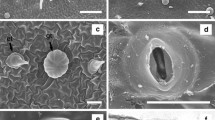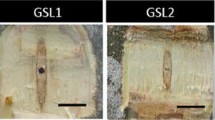Abstract
Gyrinops versteegii is a tropical, agarwood-producing tree. Agarwood is valued for its fragrant resin, which has resulted in over-harvesting of agarwood trees and their protection as endangered species. Agarwood is produced in response to physical, chemical, or biological stress, and considerable research has been devoted to identifying effective methods for artificial induction of agarwood. Among the known agarwood-forming species, most research has been carried out on species in the genus Aquilaria. In the present study, we report results of a preliminary study on the potential of Gyrinops versteegii for agarwood production using seedlings. Agarwood production in the stem of Gyrinops versteegii seedlings was evaluated in response to bark removal (wounding treatment), or inoculation with bacteria (Bacillus sp. or Alcaligenes sp.) or fungi (Fusarium solani or Paecilomyces variotii), or treatment with salicylic acid. Healthy unwounded seedlings were included in the analyses as negative controls. We found that terpene was formed in response to all treatments and mainly accumulated in the interxylary phloem and xylem rays. Analysis for volatile chemicals using gas chromatography-mass spectrometry revealed that sesquiterpenes were only detected in stems treated with the fungus, Fusarium solani, and that chromones were present in stems inoculated with bacteria or fungi. Our results demonstrate that both biological and chemical agents have the potential to induce the biosynthesis of agarwood resin components in Gyrinops versteegii seedlings. Among these, Fusarium solani was the most effective agent. We anticipate that this study will lead to a more elaborate study of agarwood formation in the genus Gyrinops.






Similar content being viewed by others
References
Adams SJ, Manohara T, Krishnamurthy K, Kumar TS (2016) Histochemical studies on fungal-induced agarwood. Indian J Plant Sci 5:102–110
Agrios G (2005) Plant pathology, 5th edn. Elsevier Academia Press, San Diego
Auri A, Faridah E, Sumardi, Hardiwinoto S (2021) The effect of crown pruning and induction of Acremonium sp. on agarwood formation in Gyrinops caudata in West Papua, Indonesia. Biodiversitas 22:2604–2611. https://doi.org/10.13057/biodiv/d220707
Azren PD, Lee SY, Emang D, Mohamed R (2019) History and perspectives of induction technology for agarwood production from cultivated Aquilaria in Asia: a review. J For Res 30:1–11. https://doi.org/10.1007/s11676-018-0627-4
Bhore SJ, Preveena J, Kandasamy KI (2013) Isolation and identification of bacterial endophytes from pharmaceutical agarwood-producing Aquilaria species. Pharmacogn Res 5:134–137. https://doi.org/10.4103/0974-8490.110545
Chhipa H, Kaushik N (2017) Fungal and bacterial diversity isolated from Aquilaria malaccensis tree and soil, induces agarospirol formation within 3 months after artificial infection. Front Microbiol 8:1286. https://doi.org/10.3389/fmicb.2017.01286
Dai ZB, Wang X, Li GH (2020) Secondary metabolites and their bioactivities produced by Paecilomyces. Molecules 25:21. https://doi.org/10.3390/molecules25215077
Dwianto W, Kusumah S, Darmawan T, Amin Y, Bahanawan A, Pramasari D, Lestari E, Himmi S, Hermiati E, Fatriasari W, Laksana R, Damayanti R (2019) Anatomical observation and characterization on basic properties of agarwood (gaharu) as an Appendix II CITES. IOP Conf Ser: Earth Environ Sci 374:012062. https://doi.org/10.1088/1755-1315/374/1/012062
Faizal A, Azar AWP, Turjaman M, Esyanti RR (2020) Fusarium solani induces the formation of agarwood in Gyrinops versteegii (Gilg.) Domke branches. Symbiosis 81:15–23. https://doi.org/10.1007/s13199-020-00677-w
Faizal A, Esyanti RR, Adn’ain N, Rahmani S, Azar AWP, Iriawati, Turjaman M (2021) Methyl jasmonate and crude extracts of Fusarium solani elicit agarwood compounds in shoot culture of Aquilaria malaccensis. Lamk Heliyon 7:e06725. https://doi.org/10.1016/j.heliyon.2021.e06725
Faizal A, Esyanti RR, Aulianisa EN, Iriawati, Santoso E, Turjaman M (2017) Formation of agarwood from Aquilaria malaccensis in response to inoculation of local strains of Fusarium solani. Trees 31:189–197. https://doi.org/10.1007/s00468-016-1471-9
Gusmailina, Sumadiwangsa S (2020) The enhancement of added value of agarwood by diversification product. IOP Conf Ser Earth Environ Sci 591:012022. https://doi.org/10.1088/1755-1315/591/1/012022
Hidayat A, Turjaman M, Qamyari R, Imanuddin R, Tohir D, Rahmanto R, Susilowati A (2021) Bioactive composition, antifungal, antioxidant, and anticancer potential of agarwood essential oil from decaying logs (Gyrinops spp.) of Papua Island (Indonesia). J Appl Pharm Sci 11:70–78. https://doi.org/10.7324/JAPS.2021.1101010
Ito M, Okimoto K, Yagura T, Honda G (2005) Induction of sesquiterpenoid production by methyl-jasmonate in Aquilaria sinensis cell suspension culture. J Essent Oil Res 17:175–180
Jayaraman S, Mohamed R (2015) Crude extract of Trichoderma elicits agarwood substances in cell suspension culture of the tropical tree, Aquilaria malaccensis Lam. Turk J Agric For 39:163–173
Khare S, Singh NB, Singh A, Hussain I, Niharika K, Yadav V, Bano C, Yadav RK, Amist N (2020) Plant secondary metabolites synthesis and their regulations under biotic and abiotic constraints. J Plant Biol 63:203–216. https://doi.org/10.1007/s12374-020-09245-7
Knogge W (1996) Fungal infection of plants. Plant Cell 8:1711–1722. https://doi.org/10.1105/tpc.8.10.1711
Kunkel BN, Brooks DM (2002) Cross talk between signaling pathways in pathogen defense. Curr Opin Plant Biol 5:325–331. https://doi.org/10.1016/S1369-5266(02)00275-3
Li W, Chen H-Q, Wang H, Mei W-L, Dai H-F (2021) Natural products in agarwood and Aquilaria plants: chemistry, biological activities and biosynthesis. Nat Prod Rep 38:528–565. https://doi.org/10.1039/D0NP00042F
Liu J, Xu Y, Zhang Z, Wei J (2015) Hydrogen peroxide promotes programmed cell death and salicylic acid accumulation during the induced production of sesquiterpenes in cultured cell suspensions of Aquilaria sinensis. Func Plant Biol 42:337–346. https://doi.org/10.1071/FP14189
Liu P, Zhang X, Yang Y, Sui C, Xu Y, Wei J (2019) Interxylary phloem and xylem rays are the structural foundation of agarwood resin formation in the stems of Aquilaria sinensis. Trees 33:533–542. https://doi.org/10.1007/s00468-018-1799-4
Liu Y, Chen H, Yang Y, Zhang Z, Wei J, Meng H, Chen W, Feng J, Gan B, Chen X, Gao Z, Huang J, Chen B, Chen H (2013) Whole-tree agarwood-inducing technique: an efficient novel technique for producing high-quality agarwood in cultivated Aquilaria sinensis trees. Molecules 18:3086
Lv F, Li S, Feng J, Liu P, Gao Z, Yang Y, Xu Y, Wei J (2019) Hydrogen peroxide burst triggers accumulation of jasmonates and salicylic acid inducing sesquiterpene biosynthesis in wounded Aquilaria sinesis. J Plant Phys 234–235:167–175. https://doi.org/10.1016/j.jplph.2019.02.006
Mochahari D, Kharnaior S, Sen S, Thomas SC (2020) Isolation of endophytic fungi from juvenile Aquilaria malaccensis and their antimicrobial properties. J Trop For Sci 32:97–104
Moreno-Gavíra A, Diánez F, Sánchez-Montesinos B, Santos M (2020) Paecilomyces variotii as a plant-growth promoter in horticulture. Agronomy 10:597
Mulyaningsih T, Yamada I (2018) Three new species of Aquilaria (Thymelaeaceae) from Borneo Indonesia. AIP Conf Proceed 2023:020114. https://doi.org/10.1063/1.5064111
Munasinghe DSP, Somaratne S, Weerakoon SR, Ranasinghe C (2021a) Production of sesquiterpenes by electro-elicitation in Gyrinops walla Gaetner calli and cell suspension cultures. EuroBiotech J 5:70–78. https://doi.org/10.2478/ebtj-2021-0011
Munasinghe S, Somaratne S, Weerakoon S, Ranasinghe C (2021b) Sustainable utilization of Gyrinops walla Gaetner: in vitro production of sesquiterpenes by chemical and biological elicitation. J Genet Eng Biotechnol 19:134. https://doi.org/10.1186/s43141-021-00187-2
Naef R (2011) The volatile and semi-volatile constituents of agarwood, the infected heartwood of Aquilaria species: a review. Flavour Frag J 26:73–87. https://doi.org/10.1002/ffj.2034
Nasution AA, Siregar UJ, Miftahudin, Turjaman M (2020) Identification of chemical compounds in agarwood-producing species Aquilaria malaccensis and Gyrinops versteegii. J For Res 31:1371–1380. https://doi.org/10.1007/s11676-018-00875-9
Naziz PS, Das R, Sen S (2019) The scent of stress: evidence from the unique fragrance of agarwood. Front Plant Sci 10. https://doi.org/10.3389/fpls.2019.00840
Nobuchi T, Siripatanadilok S (1991) Preliminary observation of Aquilaria crassna wood associated with the formation of aloeswood bult. Kyoto Univ 63:226–235
Okudera Y, Ito M (2009) Production of agarwood fragrant constituents in Aquilaria calli and cell suspension cultures. Plant Biotechnol 26:307–315. https://doi.org/10.5511/plantbiotechnology.26.307
Rahayu G, Santoso E, Wulandari E (2010) Effectivity and interaction between Acremonium sp. and Fusarium sp. in formation of gaharu sapwood in Aquilaria microcarpa Baill. Info Hutan 7:155–164
Rawana HS, Budiadi, Rahayu S (2020) The effect of phenolics in agarwood formation of Gyrinops versteegii tree induced by Fusarium sp. AIP Conf Proceed 2260:090001. https://doi.org/10.1063/5.0015753
Ren C-G, Dai C-C (2012) Jasmonic acid is involved in the signaling pathway for fungal endophyte-induced volatile oil accumulation of Atractylodes lancea plantlets. BMC Plant Biol 12:128. https://doi.org/10.1186/1471-2229-12-128
Sangareswari M, Parthiban KT, Kanna SU, Karthiba L, Saravanakumar D (2016) Fungal microbes associated with agarwood formation. Am J Plant Sci 7:8. https://doi.org/10.4236/ajps.2016.710138
Sen S, Dehingia M, Talukdar NC, Khan M (2017) Chemometric analysis reveals links in the formation of fragrant bio-molecules during agarwood (Aquilaria malaccensis) and fungal interactions. Sci Rep 7:44406. https://doi.org/10.1038/srep44406
Shah J, Zeier J (2013) Long-distance communication and signal amplification in systemic acquired resistance. Front Plant Sci 4. https://doi.org/10.3389/fpls.2013.00030
Singh M, Kumar A, Singh R, Pandey KD (2017) Endophytic bacteria: a new source of bioactive compounds. 3 Biotech 7:315. https://doi.org/10.1007/s13205-017-0942-z
Subasinghe SMCUP, Hettiarachchi DS (2015) Characterisation of agarwood type resin of Gyrinops walla Gaertn growing in selected populations in Sri Lanka. Ind Crops Prod 69:76–79. https://doi.org/10.1016/j.indcrop.2015.01.060
Subasinghe SMCUP, Hitihamu HID, Fernando KMEP (2019) Use of two fungal species to induce agarwood resin formation in Gyrinops walla. J For Res 30:721–726. https://doi.org/10.1007/s11676-018-0654-1
Susilo A, Kalima T, Santoso E (2014) Panduan lapangan pengenalan jenis pohon penghasil gaharu Gyrinops spp. di Indonesia. International Tropical Timber Organization (ITTO) - CITES Phase II Project, Bogor
Tan CS, Isa NM, Ismail I, Zainal Z (2019) Agarwood induction: current developments and future perspectives. Front Plant Sci 10:122. https://doi.org/10.3389/fpls.2019.00122
Turjaman M, Hidayat A, Santoso E (2016) Development of agarwood induction technology using endophytic fungi. In: Mohamed R (ed) Agarwood: Science Behind the Fragrance. Springer, Singapore, pp 57–71. https://doi.org/10.1007/978-981-10-0833-7_4
Wang Y, Mostafa S, Zeng W, Jin B (2021) Function and mechanism of jasmonic acid in plant responses to abiotic and biotic stresses. Int J Mol Sci 22:8568. https://doi.org/10.3390/ijms22168568
Wangiyana I, Nugraheni Y, Anggadhania L, Soetarto E (2021) Morphological and DNA polymorphism analyses of Fusarium solani isolated from Gyrinops versteegii in the West Nusa Tenggara Forest. ASM Sci J 14:65–74
Xu Y, Zhang Z, Wang M, Wei J, Chen H, Gao Z, Sui C, Luo H, Zhang X, Yang Y, Meng H, Li W (2013) Identification of genes related to agarwood formation: transcriptome analysis of healthy and wounded tissues of Aquilaria sinensis. BMC Genomics 14:227. https://doi.org/10.1186/1471-2164-14-227
Yamaoka Y, Kuroki D, Matsutani K, Aoyama T, Masuya H, Kajimura H (2015) Pathogenicity of Fusarium solani associated with a bark beetle, Scolytogenes birosimensis, to Pittosporum tobira. J For Res 20:514–521. https://doi.org/10.1007/s10310-015-0505-2
Zhang Z, Han X-m, Weil J-h, Xue J, Yang Y, Liang L, Li X-j, Guo Q-m, Xu Y-h, Gao Z-h (2014a) Compositions and antifungal activities of essential oils from agarwood of Aquilaria sinensis (Lour.) Gilg induced by Lasiodiplodia theobromae (Pat.) Griffon. & Maubl. J Braz Chem Soc 25:20–26
Zhang Z, Wei J, Han X, Liang L, Yang Y, Meng H, Xu Y, Gao Z (2014b) The sesquiterpene biosynthesis and vessel-occlusion formation in stems of Aquilaria sinensis (Lour.) Gilg trees induced by wounding treatments without variation of microbial communities. Int J Mol Sci 15:23589–23603. https://doi.org/10.3390/ijms151223589
Zhao J, Davis LC, Verpoorte R (2005) Elicitor signal transduction leading to production of plant secondary metabolites. Biotechnol Adv 23:283–333. https://doi.org/10.1016/j.biotechadv.2005.01.003
Acknowledgements
This research was partially funded by the Ministry of Education, Culture, Research, and Technology/National Research and Innovation Agency, Republic of Indonesia through competitive grant under the scheme of World Class Research (contract number: 079/E4.1/AK.04.PT/2021) awarded to A.F.
Author information
Authors and Affiliations
Contributions
A.F., D.H., and A.R. designed the study, developed the methodology, performed the experiment, analyzed the data, and wrote the manuscript. E.J., A.W.P.A, and M.M.M. performed the experiment, and analyzed the data. M.T. developed the methodology and analyzed the data.
Corresponding author
Ethics declarations
Conflict of interest
The authors declare no conflict of interest. The financial supporter had no role in the design of the study, perform the experiment and in the decision to publish the results.
Additional information
Publisher’s note
Springer Nature remains neutral with regard to jurisdictional claims in published maps and institutional affiliations.
Supplementary Information
Below is the link to the electronic supplementary material.
ESM 1
(DOCX 4.17 MB)
Rights and permissions
About this article
Cite this article
Faizal, A., Hermawaty, D., Junita, E. et al. Evaluation of biotic and abiotic stressors to artificially induce agarwood production in Gyrinops versteegii (Gilg.) Domke seedlings. Symbiosis 86, 229–239 (2022). https://doi.org/10.1007/s13199-022-00835-2
Received:
Accepted:
Published:
Issue Date:
DOI: https://doi.org/10.1007/s13199-022-00835-2




